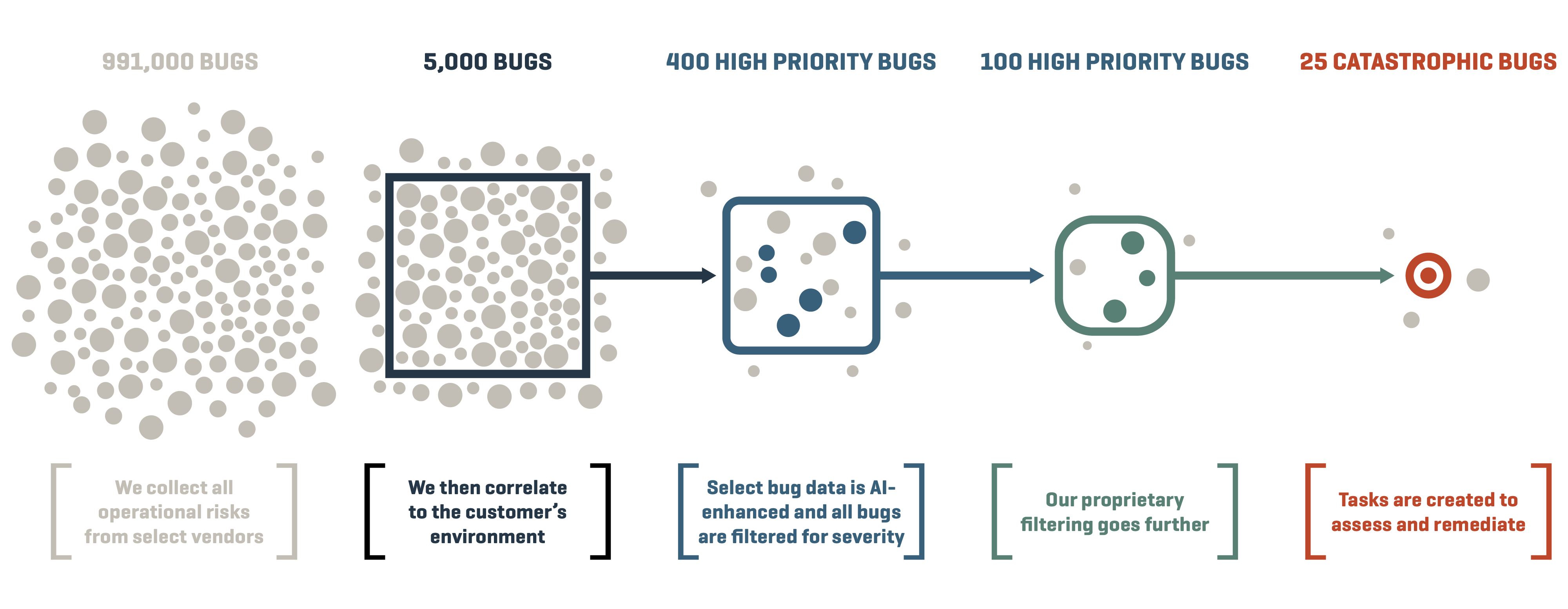

Miles Lancaster
January 26th, 2024
The unfortunate reality of today’s IT operations is a ceaseless onslaught of vendor software updates and bug reports. The goal of operational efficiency often becomes a high-stakes gamble of weighing the time required to find all the critical bugs against the countless other priorities. After all, if a bug impacts a critical system, the cost of outages and downtime can be staggering.
But how to solve this challenge of vendor bug management when there’s so much noise? The current strategy is a combination of accepting risk, peppered with patchwork fixes – a.k.a. the kind of tepid defense that is statistically guaranteed to fail at some point. Further, this challenge isn’t going anywhere. Reports say that IT outages are only getting worse. It’s a day-to-day reality that needs to be dealt with, even if there aren’t resources to properly do so.
What if there was a way to turn the typically manual and exhausting process of vendor bug management into an automated, strategic operation?
Our team has created just that. Our innovative solution identifies the critical vendor bugs that actually need your attention. We built this solution because we understand that no team, person, or entity can – or should – try to wrestle with this alone. Instead, BugZero sifts through the noise, sparing you this chaos by fully integrating into your IT ecosystem. And research shows that the implementation of proactive technologies can help improve your operational resilience and reduce unplanned downtime by 50%.
As a strategic partner, BugZero aims to be not just another vendor, but instead a vital part of your operations by highlighting the critical vendor bugs hiding in your IT state. Below, we showcase not only how we do this, but also why it’s important.
Navigating the never-ending deluge of vendor bugs is a task many organizations find daunting to the point of paralysis. This often results in tuning out the static, only to be caught off guard later on.
But this is also understandable. Enterprises are responsible for countless systems and are inundated with alerts, updates, and an array of bug notifications. Not to mention being beheld to various regulations across the world!
And vendor bugs are as diverse in their format as they are in their frequency, always hiding in vendor hardware and software. Because of this reality, the result is a reactive stance where only the fires burning brightest are addressed – and the potential impact of all the other smoldering issues are left to chance. You don’t have to know about Smokey the Bear to know that’s not a good strategy for safety.
Further, the process is not only overwhelming, it’s unsustainable. ITOps are expected to subscribe to various vendors’ communications, create accounts on multiple portals, and set reminders for checking updates. These simple tasks snowball into a full-time endeavor and add to the noise IT Ops have to filter through. As a result, bugs are often lost.
While some vendors, such as Cisco, provide tools for bug management. Others leave IT teams drowning in a sea of updates without much guidance. It’s a passive and piecemeal approach to a problem that really requires active management.
For IT operations teams, this isn’t just an annoying chore. It makes this part of your job impossible, because the vast quantity of information is also extremely complex. You know what they say about searching for a needle in a haystack? Well, imagine that happening on a daily basis.
Of course, an active approach to filtering out noise is much easier said than done. That’s why we automated the process – one that functions proactively, not reactively.
The BugZero automated solution is systematic. Our agentless platform continuously scans for new bugs from every vendor, ensuring that nothing slips through the cracks.
It’s not an approach that collects data randomly. The system is finely tuned to match the bugs against your specific products, models, and versions. This is significant because it means we bring to your attention only those issues that pertain to your environment – filtering out whatever other clutter is irrelevant.
Furthermore, we’ve built this concept upon the Operational Defect Database (ODD), a free online resource that we’ve created. The ODD acts as a central repository of operational defects similar to what the National Vulnerability Database is for security vulnerabilities. In other words, it’s a public and searchable database of all known bugs from supported vendors.
How does BugZero work in practice? Let’s break down our solution’s approach to finding software bugs.
BugZero is tailored to a client’s unique situation and environment. It correlates against your CMDB, and by plugging directly in, we shape our filtering mechanisms to work within your specific environment. The integration not only significantly improves the relevance of data, but nearly eliminates the noise.
Our advanced algorithms then perform an analysis of each defect – assigning a bug risk score that reflects the potential impact on your environment. This risk score ensures a level of intelligence to our tech – ensuring that the filtering isn’t just thorough, but smart. With BugZero, your defense against vendor bugs is not just for show. It’s tailored to your operational resilience needs, helping safeguard your system integrity and availability. Here’s how we filter your vendor hardware & software bugs:
CMDB Integration: This filter aligns with your CMDB to present only the bugs that currently exist in in your environment.
Component Filter: Analyzes software bug reports, identifies product components, and automatically disregards components not running in your systems.
Keyword Exclusion: Allows you to specify which terms to ignore, ensuring you and your team are not sidetracked by irrelevant bugs.
Severity Mapping: BugZero translates vendor severity ratings into your tool’s language, ensuring a uniform understanding across all platforms and vendors.
Risk Scoring: With AI, we assign a risk score to each bug, tailored to your risk threshold, allowing you and your team to focus on what truly matters for your operations.
GenAI Severity Ratings: Some vendors don’t provide a severity with their bug announcements, forcing you to read every single bug to determine if it is critical or not. We fixed that, further helping you focus only on the most important bugs.
The result is, instead of a world where you’re forced to navigate a never-ending sea of bugs, you’re presented with only the bugs that are truly critical for you. This, we believe, is immensely valuable for any IT Operations team as it leads to clear prioritization and action.

BugZero aims to go beyond providing a solution. By automating an antiquated process, organizations are able to use their time and resources more effectively.
Time is a valuable resource, and BugZero hopes to provide organizations with more of it.
In other words, it’s not about keeping up – it’s about staying ahead. With BugZero, you can turn vendor bug management into a process that’s easy, focused, and efficient.
Want to learn how BugZero can help solve your vendor bugs? Let us show you how it works.


Eric DeGrass
June 3rd, 2025


Eric DeGrass
February 21st, 2025


Eric DeGrass
February 11th, 2025
Sign up to receive a monthly email with stories and guidance on getting proactive with vendor risk
BugZero requires your corporate email address to provide you with updates and insights about the BugZero solution, Operational Defect Database (ODD), and other IT Operational Resilience matters. As fellow IT people, we hate spam too. We prioritize the security of your personal information and will only reach out only once a month with pertinent and valuable content.
You may unsubscribe from these communications at anytime. For information on how to unsubscribe, as well as our privacy practices and commitment to protecting your privacy, check out our Privacy Policy.